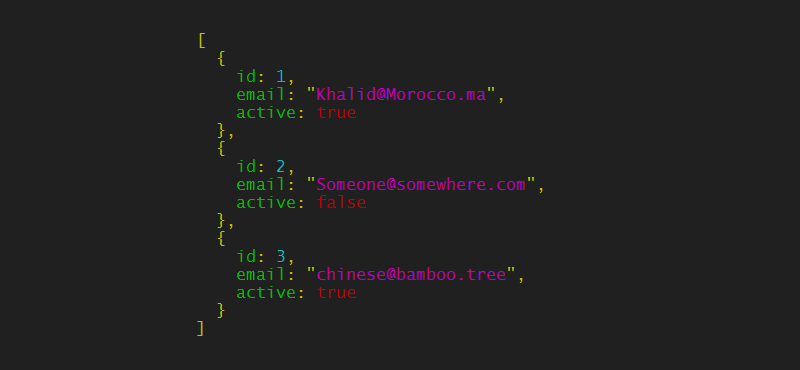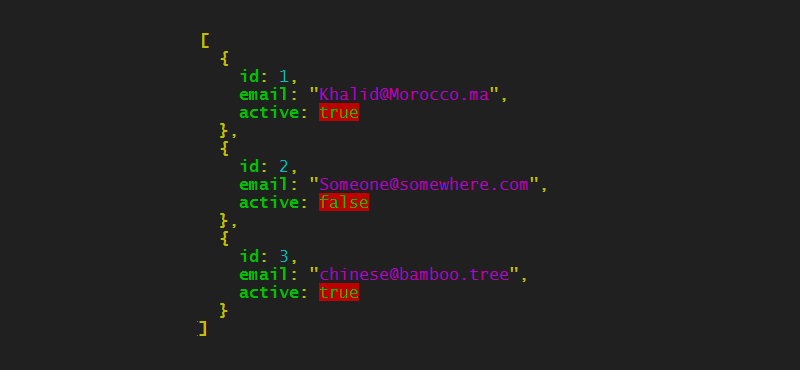https://github.com/Javascipt/Jsome
:sparkles: Make your JSON look AWESOME
https://github.com/Javascipt/Jsome
color colors json json-objects
Last synced: 9 months ago
JSON representation
:sparkles: Make your JSON look AWESOME
- Host: GitHub
- URL: https://github.com/Javascipt/Jsome
- Owner: Javascipt
- License: mit
- Created: 2015-10-09T21:06:48.000Z (about 10 years ago)
- Default Branch: master
- Last Pushed: 2023-11-29T22:26:11.000Z (about 2 years ago)
- Last Synced: 2024-04-13T19:33:00.119Z (over 1 year ago)
- Topics: color, colors, json, json-objects
- Language: JavaScript
- Homepage:
- Size: 89.8 KB
- Stars: 241
- Watchers: 5
- Forks: 24
- Open Issues: 14
-
Metadata Files:
- Readme: README.md
- License: LICENSE
Awesome Lists containing this project
- awesome-nodejs - Jsome - Pretty prints JSON with configurable colors and indentation. (Packages / Command-line apps)
- awesome-node - Jsome - Pretty prints JSON with configurable colors and indentation. (Packages / Command-line apps)
- awesome-nodejs - Jsome - Make your JSON look AWESOME - ★ 139 (Command-line apps)
- awesome-nodejs-cn - Jsome - 漂亮地打印带有可配置颜色和缩进的JSON命令. (目录 / 命令行应用)
- awesome-nodejs-cn - Jsome - 使用自定义颜色和缩进打印漂亮的 JSON (包 / 命令行程序)
- awesome-nodejs - Jsome - Pretty prints JSON with configurable colors and indentation. (Packages / Command-line apps)
- awesome-cli - jsome - Pretty format JSON on terminal. (Output)
- fucking-awesome-nodejs - Jsome - Pretty prints JSON with configurable colors and indentation. (Packages / Command-line apps)
- awesome-nodejs-precise - Jsome - square)]() | Pretty prints JSON with configurable colors and indentation. | (Packages / Command-line apps)
- awesome-nodejs-cn - Jsome - 根据配置的颜色和排版格式化打印JSON。 (包 / 命令行应用)
- awesome-nodejs-new - Jsome - Pretty prints JSON with configurable colors and indentation. (Packages / Command-line apps)
- awesome-nodejs-cn - Jsome - **star:245** 漂亮的打印json,带有可配置的颜色和缩进 (包 / 命令行程序)
README
Make your JSON objects look AWESOME!
====================================





This package allows you to give style to your JSON on your console!
## Installation :
```bash
$ npm install jsome
```
if you need to use jsome as a command line, you may need to instal it globally
```bash
$ [sudo] npm install -g jsome
```
## How does it work ?
#### Command line :
Using jsome as a command line, you need to run the following command that takes the path to your json file as argument
```bash
$ jsome /path/to/your/json/file.json
$ jsome [options] /path/to/your/json/file.json
```
You can also send a json string through a pipe (`|`)
```bash
$ cat /path/to/your/json/file.json | jsome
```
The options available are :
- `-c`: to enable or disable colors (defualt value: true)
- `-l`: to enable or disable levels (default value: false)
- `-s`: to specify the number of tabulation spaces (default value: 2)
- `-r`: to specify valid JSON as output (default value: true)
examples :
```bash
$ jsome -c false /path/to/your/file.json
$ jsome -c false -l true /path/to/your/file.json
$ jsome -s 4 /path/to/your/file.json
```
##### Module :
On your nodejs application, when you need to console.log a json object, all you need to do is to use the jsome function
```javascript
var jsome = require('jsome');
jsome([{"id":1,"email":"Khalid@Morocco.ma","active":true},{"id":2,"email":"Someone@somewhere.com","active":false},{"id":3,"email":"chinese@bamboo.tree","active":true}]);
```
Then your json object will be displayed on the console in a pretty format with Awsome colors !
Here is the result :

The `jsome` function returns the object passed as argument so that when debugging, you can print the value of an object without having to change a lot on your code
```javascript
// instead of
var foo = {
bar : obj
}
jsome (obj);
// you can do this :
var foo = {
bar : jsome(obj)
}
```
You can add some points to show levels of elements... very helpful when you are dealing with complex json objects
```javascript
jsome.level.show = true;
```

The object `jsome.level` has as default value the following json :
```javascript
jsome.level = {
'show' : false
, 'char' : '.'
, 'color' : 'red'
, 'spaces' : 2
, 'start' : 0
}
```
You can change the level char, its color ( [see chalk package](http://npmjs.org/package/chalk) ) and the number of spaces for each level.
You can also display your json starting from a specific level to avoid displaying your json starting from the extreme left. You can do that by changing the value `jsome.level.start`.
You can configure the colors of the displayed json by changing the values of the `jsome.colors` object which has as default these values.
```javascript
jsome.colors = {
'num' : 'cyan' // stands for numbers
, 'str' : 'magenta' // stands for strings
, 'bool' : 'red' // stands for booleans
, 'regex' : 'blue' // stands for regular expressions
, 'undef' : 'grey' // stands for undefined
, 'null' : 'grey' // stands for null
, 'attr' : 'green' // objects attributes -> { attr : value }
, 'quot' : 'yellow' // strings quotes -> "..."
, 'punc' : 'yellow' // commas seperating arrays and objects values -> [ , , , ]
, 'brack' : 'yellow' // for both {} and []
}
```
You can not only use the color value as string but also you can use an array to specify the background color or you can make things look bold ( [see chalk package for more details](http://npmjs.org/package/chalk) )
```javascript
jsome.colors.bool = ['green' , 'bgRed']
jsome.colors.attr = ['green' , 'bold']
jsome.colors.quot = ['yellow', 'bold']
jsome.colors.punc = ['yellow', 'bold']
jsome.colors.brack = ['yellow', 'bold']
```

When you have a json as a string, instead of passing by `JSON.parse` function, you can just call the parse function of jsome
```javascript
jsome(JSON.parse('[1,2,3]'));
```
becomes:
```javascript
jsome.parse('[1,2,3]');
```
If you need to disable the colors:
```javascript
jsome.params.colored = false;
```
If you need JSON which pases linting:
```javascript
jsome.params.lintable = true;
```
When you have a very long json to display, don't make your code blocking... you can enable the asynchronous mode.
```javascript
jsome.params.async = true;
jsome(longJson, function () {
/* Your code here */
});
```
The default value of `params` is:
```javascript
jsome.params = {
'colored' : true
, 'async' : false
, 'lintable': false
}
```
In order to get the colored string without printing it on the console :
```javascript
var coloredString = jsome.getColoredString(obj)
```